Natural-looking high dynamic range (HDR) nature photography makes a viewer feel like they are looking out of a window at a few extraordinary area. It is small ponder that these nature photographs take your breath absent and make you dream almost stopping your daytime work and going voyaging. We utilize manual presentation blending in Photoshop to form nature photographs with tall energetic extend.
In any case, the experienced landscape photographer knows that exposure blending in Photoshop isn’t a simple errand to achieve. Not as it were do you’ve got to bracket your camera exposure, but you moreover must be able to handle these bracketed camera exposure to create them see common.
Exposure Blending for Landscape Photography
There are two compelling ways to form stunning common looking tall dynamic run landscape photos.
HDR Photography
HDR (High Dynamic Range) photography refers to the robotized prepare of blending different camera presentation employing a Lightroom or a committed HDR computer program. Landscape photographers don’t got to worry around making layers and veils to mix the bracketed exposures. HDR photographs created by mechanized program regularly requires extra alteration to form characteristic looking photographs.

Manual Exposure Blending in Photoshop
This is often a manual handle for creating high energetic range photographs Exposure blending Photoshop requires a landscape photographer to make layers & veil to blend the bracketed camera exposure. Most pro photographers depend on this technique to create tall dynamic range pictures since this manual process gives them ultimate control over the ultimate result.
Since exposure blending in Photoshop encompasses a soak learning bend, tenderfoot landscape photographers are frequently hesitant to grasp this approach. If you’re fair getting begun with presentation blending Photoshop, here are a few of the common botches that you ought to attempt to avoid:
Unnatural tonal gradation in Photoshop
Since most manual exposure blending workflow utilize layers and masks in Photoshop, it is simple to end up with an unequal tall energetic extend photo which does not coordinate the light conditions on the scene. One of the common botches that a apprentice landscape photographer makes is to include as well much points of interest within the highlights.


For the over illustration from Maui, Hawaii (Image #1) appears how these unnatural tones can show up in a manual exposure blending workflow in Photoshop. You’ll see that the highlights around the sun are much darker than what was visible with the bare eye. After you are looking straightforwardly at the sun, it’s almost impossible to see all the detail and colors within the immediate vicinity of the setting sun. Moreover, the light reflecting from the water is much brighter than the sky. Image #2 shows a common looking exposure blending in Photoshop where the highlights appear the uncovered least details.
Over-processed HDR Photography
We have all seen the over-cooked HDR photography see where a landscape photographer frantically tries to make a high contrast. It is simple to discover cases of over-processed landscape photos made with automated HDR photography computer program. But, in case you’re not cautious, you’ll also over-process a photo employing a manual exposure blending in Photoshop workflow.


Don’t get me off-base. There’s nothing off-base with making an imaginative scene photo with the over-processed HDR see. However, if you need your scene photographs to see characteristic, it is best to dodge including as well much differentiate in Photoshop. Image #1 from Scotland appears a high energetic extend picture with over-processed HDR see that was created using Photoshop Layers & Masks. For image #2, I was able to utilize presentation mixing in Photoshop workflow to create a stunning natural looking scene photo.
Including unwanted artifact during Exposure Blending
Manual exposure blending in Photoshop is prone to halos, edge distortion, ghosting and other unwanted artifacts. A few of these undesirable artifacts presented amid the exposure blending workflow are promptly unmistakable. Whereas others may require you to zoom into your picture at 100% to see them.


One of the finest places to discover undesirable artifacts is close a tall contrast edge as seen in Picture #1 below. Image #2 appears a halo around a tall contrast edge within the landscape photo captured in Glacier National Stop, Montana. Ghosting in physically exposure blending workflow happens after you have moving components in your scene or in case the pictures are not superbly adjusted. Professional landscape photographers utilize glow concealing and smooth edge moves to dodge undesirable artifacts amid the exposure blending in Photoshop.
Exposure blending workflow in Photoshop grant you unimaginable control over your blending handle utilizing layers and veils. You can moreover Photoshop layers & covers to form assist refinement to your last picture as seen within the case below.
Basic Exposure Blending in Photoshop Example
Here is an landscape photo from St. Mary’s Drop in Ice sheet National Stop. I utilized Photoshop layers and covers to mix two camera introduction and to fine tune to the photo to bring out the stunning points of interest and colors in my finished picture

I utilized Adobe Camera Raw to prepare Image #1 (below) for the points of interest within the rocks. Take note that in this picture you cannot see any details within the highlights since they are overexposed. On the other hand the Image #2 is processed for the highlight within the hurrying water. You’ll see unimaginable sum of points of interest in this highlights, but the shadows are beneath uncovered. I utilized Photoshop Layers and Veil to physically mix these camera exposures to make a natural looking picture.


However, I taken note that the mixed photo required fine tuning to improve the contrast within the rocks, and to assist focus the viewer’s consideration on the St. Mary’s drop. I was able to utilize Photoshop Layers & Covers to achieve this. Here are all the Layers and Cover in Photoshop to create the last result:

Photoshop layers and cover gives me an capacity for manual exposure mixing as well as making other alteration to the picture as fundamental. Moreover, I can make these adjustments employing a non-destructive workflow in Photoshop. I can turn Photoshop layers on and off to see precisely what impact they have on one another and on the ultimate landscape photo. I can moreover refine layers and veil in Photoshop to redress my mistakes. I regularly spare the picture as a PSD record – with all those Photoshop layers and masks intaglio – and return to it many days afterward to make last corrections with new eyes.
in outline, exposure blending utilizing layers and masks in Photoshop permits me to have extreme control over my last results. This workflow can moreover be amplified to form further refinement to your photographs to bring out the wealthy details and dynamic colors merely see in nature.
